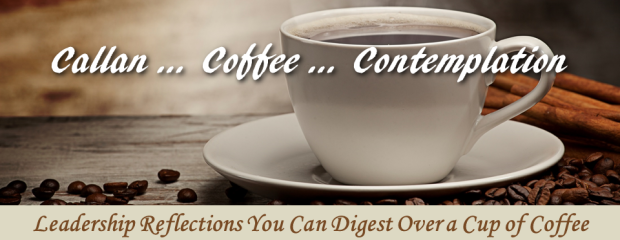Callan…Coffee…Contemplation for the Week of November 3rd
It’s Personal
I often here the phrase “it isn’t personal” when listening to people talk about work, projects, goals, or company missions. Though I appreciate these comments trying to distinguish work and individual impulses, I think we are missing a key fact of leading and following, which is this: Nothing is motivating until it is deeply personal. There are many beautifully written mission statements adorning the walls of corporate headquarters everywhere, but I doubt a single one of them, in itself, inspired individuals to wholeheartedly give their best. It is not until the company’s mission becomes a personal mission that this conversion occurs. It is not until the ethos and purpose of the company becomes a personal conviction that motivation, passion, and real ambition are released. Leaders must cultivate this conversion by enabling the general mission to become a personal mission. I believe this conversion takes place slowly, built on painstakingly-laid foundations of trust, meaning, high purpose, and high standards. So yes; leading, and the choice to be a champion, is very personal.
Restlessness
Though leaders seek to gain balance in their lives, the reality is, great leadership requires times of restlessness and imbalance. Why so? Because great leadership demands unquenchable curiosity driving us always to do something more. This restlessness is not only healthy, but necessary for elevating leadership and organizational excellence. Restlessness is what keeps leaders attuned to change, but equally, always pointed towards the future. Great leaders have a natural questioning in which they constantly test the status quo and consistently challenge dogma and ideology. They value truth over ego, and excellence over the bottom line. I like to think of great leaders assuming the posture of an Olympic sprinter in the starting blocks awaiting the starter’s gun. They touch the ground with their hands to remind them of the non-negotiable center of their character and ethos, but simultaneously, they are poised like a catapult to move into action and engage an uncertain future. This restlessness keeps them coiled like a spring—pointed toward the future–always dedicated to above-and-beyond excellence.
A Daily Choice
Part of the reason I pen these reflections is to remind myself that leadership is a daily choice. Yes, we must develop an enduring leadership paradigm to guide us over the long term. But the more pressing reality is we wake each day with a choice to make; to lead or not lead. And more importantly—we choose the quality of our leadership response to even the smallest of things. Yes–leadership is a choice. We must start each day with a kind of personal huddle; a brief pit stop before we rush into each day, where we can center ourselves and remind ourselves of our capacity for heroic leadership that day. Great leadership is not just one’s capacity to respond to a momentous occasion; rather, it is an intentional choice to live our life heroically, in even the smallest opportunity provided. Heroic leadership is a mindset—a conscious approach to life. The important thing in leading is not the magnitude of the opportunity, but rather, the quality and consistency of our response. Every day, we face this choice. Every day, we must answer. In the end, this daily choice makes all the difference.
Creative Tension
Contemplate innovation for a moment. Do you believe great creativity comes mostly from thinking outside the box? I did too, until I reflected more deeply on the nature of explosive change and further examined the alchemy behind ingenuity. What I now believe is this: Innovation occurs best in a place of creative tension, where leaders can accommodate both a non-negotiable core and radical change. It seems to me any great revolution or breakthrough comes when leaders can, on the one hand, stand firm on the non-changing core of their organization (ethos) while simultaneously embracing an openness to change (tactics or techniques). We have to stand firm on perennially significant elements like ethos while accepting a kind of indifference to those things that must, and can, change. The more I study how great leaders navigate the roiling waters of change, the more I am certain the ability to hold oneself in creative tension between non-negotiables and negotiables is the key to innovation. Peak performance and true ingenuity break forth only when the two are combined.
Surviving Versus Thriving
I believe all organizations—companies, teams, militaries, non-profits—exist on a continuum ranging from surviving to thriving. At any time, an organization can move left or right on that continuum. There is no guarantee a currently thriving organization will stay at peak performance. Similarly, there is no reason a merely surviving organization cannot, through revitalized leadership, re-emerge as a thriving enterprise. In my study of history, and in my personal experience, I believe bad things happen when we start to confuse leadership with surviving. The slippery slope to a survival mindset begins when leaders get comfortable with the status quo, embrace self interest, and worship stale dogmas, static ideologies, and group think. When leaders embrace a survival mindset, heroic impulses die and heroic leadership vanishes. When organizations focus on surviving, elevating purposes get replaced by personal greed and covering one’s backside. Great leaders never confuse leadership with surviving, and thus, they keep themselves and their people thriving.
Check back next Monday for a round up of this week’s social media shares. Or check us out on Facebook, Twitter, Google+, or Pinterest to see our posts every day!
Tweet Share






